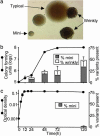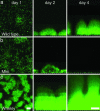Self-generated diversity produces "insurance effects" in biofilm communities
- PMID: 15546998
- PMCID: PMC528905
- DOI: 10.1073/pnas.0407460101
Self-generated diversity produces "insurance effects" in biofilm communities
Abstract
Diversity generally protects communities from unstable environmental conditions. This principle, known as the "insurance hypothesis," has been tested in many different ecosystems. Here we show that the opportunistic pathogen Pseudomonas aeruginosa undergoes extensive genetic diversification during short-term growth in biofilm communities. The induced genetic changes are produced by a recA-dependent mechanism and affect multiple traits, including the behavior of the bacteria in biofilms. Some biofilm-derived variants exhibit an increased ability to disseminate, whereas others manifest accelerated biofilm formation. Furthermore, the presence of these functionally diverse bacteria increases the ability of biofilms to resist an environmental stress. These findings suggest that self-generated diversity in biofilms provides a form of biological insurance that can safeguard the community in the face of adverse conditions.
Figures





Comment in
-
Microbial ecology comes of age and joins the general ecology community.Proc Natl Acad Sci U S A. 2004 Dec 7;101(49):16983-4. doi: 10.1073/pnas.0407886101. Epub 2004 Nov 30. Proc Natl Acad Sci U S A. 2004. PMID: 15572449 Free PMC article. No abstract available.
-
Biofilm diversity as a test of the insurance hypothesis.Microbiology (Reading). 2005 Sep;151(Pt 9):2815-2816. doi: 10.1099/mic.0.28026-0. Microbiology (Reading). 2005. PMID: 16151192 No abstract available.
References
-
- Hoiby, N., Krogh Johansen, H., Moser, C., Song, Z., Ciofu, O. & Kharazmi, A. (2001) Microbes Infect. 3, 23–35. - PubMed
-
- Costerton, J. W., Stewart, P. S. & Greenberg, E. P. (1999) Science 284, 1318–1322. - PubMed
-
- Lindsay, J. O., Ciesielski, C. J., Scheinin, T., Hodgson, H. J. & Brennan, F. M. (2001) J. Immunol. 166, 7625–7633. - PubMed
-
- Parsek, M. R. & Singh, P. K. (2003) Annu. Rev. Microbiol. 677–701. - PubMed
-
- Islam, M. S., Drasar, B. S. & Bradley, D. J. (1990) J. Trop. Med. Hyg. 93, 133–139. - PubMed
MeSH terms
Substances
LinkOut - more resources
Full Text Sources
Other Literature Sources

